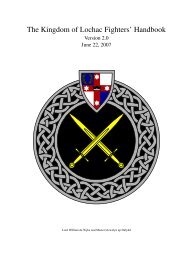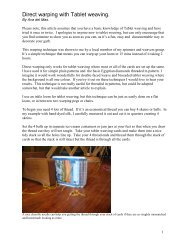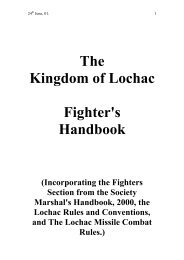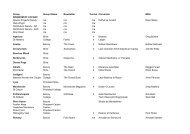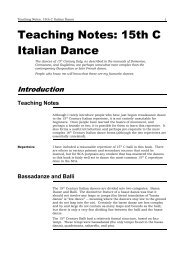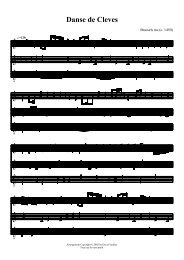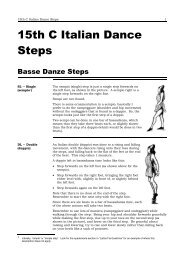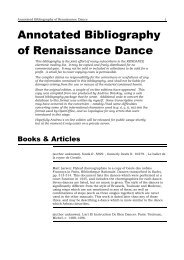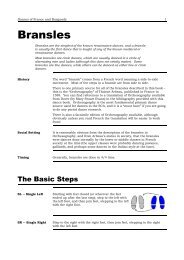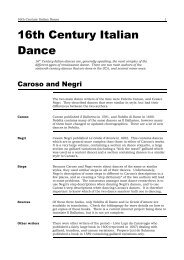15th Century Italian Dance
15th Century Italian Dance
15th Century Italian Dance
You also want an ePaper? Increase the reach of your titles
YUMPU automatically turns print PDFs into web optimized ePapers that Google loves.
<strong>15th</strong> <strong>Century</strong> <strong>Italian</strong> <strong>Dance</strong> 7Perfect DancingOf course, there is a lot more to perfect dancing than just knowing all ofthe steps and timing. Domenico talks in his treatise about grace, maniera,and “fantasmata”, which is a “physical quickness which is controlled bythe understanding of the misura”.Cornazano also talks quite a bit about dance style. The important pointsthat he raises include the following:Memoria (memory)“Memoria entails that you must remember the steps that you intend toperform, displaying the principles of dancing.”Misura (measure)“Misura is other than remembering the dance, that you must make yoursteps in orderly arrangement and in accordance with your musician”.Misura is the ability to be able to relate the knowledge of the steps to thetiming of the music, and the ability to physically relate them together onthe dance floor.Maniera (manner)“Maniera is, besides remembering the dance and moving with misura, thatyou must give attention to the things that you are performing:campeggiano and ondeggiano with the torso, in accordance with the footthat moves. For instance when you move the right foot to perform adoppio, you must cameggiare on the left foot which remains on theground, and somewhat turn the torso to that side, ondeggiare during thesecond short step and elevate suavely above that one, and with the samegrace lower on the third step that completes the doppio.”The objective here is to keep the body moving with the feet. When movingforwards on the second beat of a doppio, raise your body up and turn yourtorso (hip and shoulder) towards the direction of movement. On the finalbeat of a doppio, lower the body again and straighten the shoulders.This achieves a very different style compared with the French andBurgundian dances, and also quite different to the 16th century <strong>Italian</strong>dances which use shoulder and body movement in a very different way.Aire“Aire ... will cause you to be pleasureable to those who watch you. Aboveall, you must perform with a happy countenance and cheerfully.”Diversita di cose“Diversita di cose is being able to perform different dances successivelyand never making one like the other, that is, execute [the steps] in variousstyles. That which has been done once, do not repeat it immediately -- butthis section applies more to the man than to the woman.”



